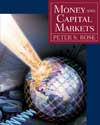 |  Money and Capital Markets: Financial Institutions and Instruments in a Global Marketplace, 8/e Peter Rose,
Texas A & M University
The Commercial Banking Industry
Chapter SummaryThe banking industry has undergone significant financial and structural changes in recent
years as well as expanding the number of services that banks offer to the public.
- One key trend reshaping the global banking industry is consolidation into fewer, but
larger, banks serving geographically broader markets. Banking is one of the leading industries
in mergers and acquisitions each year.
- Inside the United States the spread of larger banks has been accomplished through the
rapid expansion of branch banks, bank holding companies, and interstate banking firms.
In Europe banking units are spreading throughout the European Community, crossing
national boundaries and also investing in banking facilities inside the United States.
- Leading banks around the globe have reached out to become universal banks, offering
not only traditional services (including checking and savings deposits and loans) but
also securities underwriting, insurance policy sales and underwriting, real estate services,
and longer-term corporate funding, generating new sources of revenue but also
new risks for the banking community. Large banks increasingly are experiencing convergence,
offering many of the same services as other financial industries, such as in-surance
companies and security firms.
- Cost pressures have encouraged banks not only to grow larger, but to automate as many
of their services as possible. This has enabled many banks to reduce the number of their
employees and close many full-service branch offices.
- A growing list of bank services are now being offered through automated teller machines
(ATMs), through computer networks, and via telephones, satellites, and cable
television systems. In short, banking is becoming a more heavily fixed-cost industry
(based on greater volumes of capital equipment) with a smaller proportion of variable
costs (especially labor time).
- The industry’s financial statements are undergoing changes paralleling the above-noted
structural changes. More of a bank’s resources today typically are devoted to loans and to nontraditional fee-generating services (such as assisting customers with purchases
and sales of securities and with financial planning). At the same time nondeposit borrowings
and bank stockholders’ capital have grown as sources of bank funds while deposits—
the traditional main source of bank funding—have become somewhat less
important as a key source of bank funding.
- Finally, banks are still the most important institution in most financial systems around
the globe. And they remain the leading financial institution in creating money. Banks
create money both by offering checkable deposits and by granting loans (credit). However,
more and more nonbank financial institutions are competing with banks in money
and credit creation, offering parallel services and posing increasingly intense competition
for the banking industry.
|
|




 2003 McGraw-Hill Higher Education
2003 McGraw-Hill Higher Education